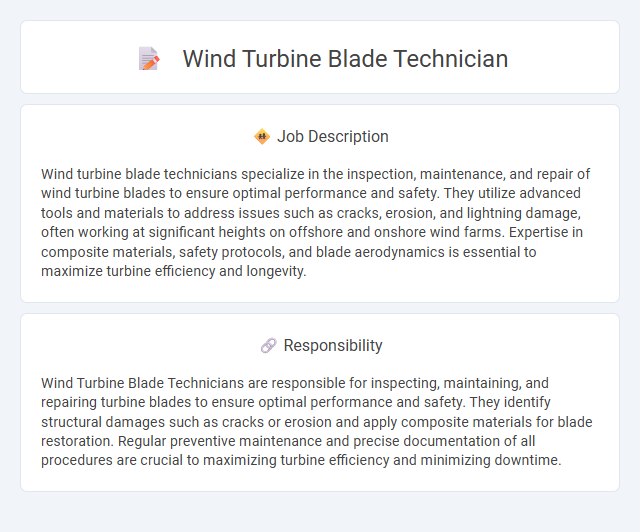
Wind turbine blade technicians specialize in the inspection, maintenance, and repair of wind turbine blades to ensure optimal performance and safety. They utilize advanced tools and materials to address issues such as cracks, erosion, and lightning damage, often working at significant heights on offshore and onshore wind farms. Expertise in composite materials, safety protocols, and blade aerodynamics is essential to maximize turbine efficiency and longevity.
Individuals with a strong physical condition and the ability to work at heights are likely well-suited for the role of a Wind Turbine Blade Technician. Those comfortable with outdoor environments, often in varying weather conditions, probably adapt better to the demands of this job. Candidates with good problem-solving skills and attention to safety protocols are more probable to succeed in maintaining and repairing turbine blades effectively.
Qualification
Wind Turbine Blade Technicians typically require specialized training in wind energy technology, mechanical systems, or composite materials, often obtained through vocational schools or technical colleges. Candidates must possess strong skills in blade inspection, maintenance, repair techniques, and safety protocols, alongside physical fitness for working at heights and in varying weather conditions. Certification programs such as the Global Wind Organisation (GWO) training enhance employability by demonstrating competency in first aid, manual handling, and working at heights specific to wind turbine maintenance.
Responsibility
Wind Turbine Blade Technicians are responsible for inspecting, maintaining, and repairing turbine blades to ensure optimal performance and safety. They identify structural damages such as cracks or erosion and apply composite materials for blade restoration. Regular preventive maintenance and precise documentation of all procedures are crucial to maximizing turbine efficiency and minimizing downtime.
Benefit
Wind Turbine Blade Technicians likely experience strong benefits such as competitive salaries and opportunities for career advancement within the renewable energy sector. Health insurance and retirement plans are probably common perks offered by employers to attract skilled workers. The role may also provide the advantage of working outdoors with cutting-edge technology, appealing to those interested in sustainable energy careers.
Challenge
Wind turbine blade technician roles likely involve challenging conditions such as working at significant heights and in varying weather scenarios, which require strong safety awareness and physical endurance. The complexity of diagnosing and repairing composite materials on blades may pose technical difficulties needing specialized skills and continuous learning. There is a probable need to adapt quickly to evolving technologies and maintenance techniques within renewable energy sectors.
Career Advancement
Wind Turbine Blade Technicians can progress from entry-level maintenance and repair roles to senior positions such as Blade Lead Technician or Maintenance Supervisor by gaining expertise in composite materials and advanced repair techniques. Certifications in safety protocols and climbing skills enhance job prospects, while experience with inspection technologies can lead to specialized roles in quality control or technical training. Career advancement often involves transitioning into project management or engineering support within the renewable energy sector.
 kuljobs.com
kuljobs.com